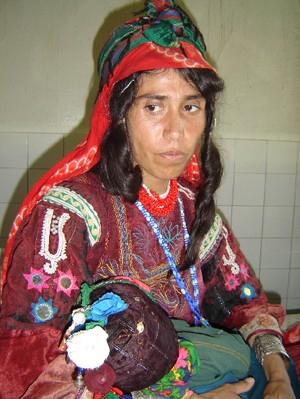Family planning services are available in over 90 percent of health facilities across Afghanistan but the number of women using them in rural areas is too low, according to the Ministry of Public Health (MoPH).
Hamida Ebadi, director of MoPH’s reproductive health unit, reckoned only 14-15 percent of women in rural and remote regions use family planning services.

Afghanistan has the second highest maternal mortality rate in the world, according to UNICEF (Photo: Masoud Popalzai/IRIN)
“The number of women using these services in urban areas is higher than in rural areas but we don’t have formal statistics to show the disparity,” Ebadi told IRIN in Kabul.
Several NGOs and the MoPH are involved in the delivery of family planning services, which include professional advice on gaps between pregnancies and free distribution of contraceptives, including condoms, tablets and injections.
Second only to Sierra Leon, Afghanistan has one of the highest maternal mortality ratios in the world with 1,600 deaths per 100,000 live births (24,000 preventable deaths every year), according to the UN Population Fund (UNFPA).
Most pregnancy-related deaths happen in remote, isolated and insecure areas of the country where people have poor access to quality health services, officials say.
Taboo
“The majority of people here are not familiar with family planning and contraceptives,” said Narghes Azimi, a health worker in the southern province of Kandahar.
“Sex and contraceptives are strong taboos here,” she said.
Lack of awareness and strong conservative traditions which often hamper women’s access to health centres are major reasons why family planning measures are not making much headway in the countryside, health experts say.
“Lack of female health personnel also inhibit women’s access to health services because many men do not permit women to be seen by a male doctor or nurse,” said Hamida Elmi, head of an obstetric hospital in the northern city of Mazar-i-Sharif.
Backed by the government, UNFPA has been training imams from around the country on the benefits of family planning and pregnancy gaps in a bid to increase public awareness and reduce pregnancy-related maternal deaths.
However, health officials acknowledge the problems of reproductive health in rural areas go far beyond a lack of awareness or restrictive traditions.
Insecurity, the high prevalence of child marriages, the dearth of professional female health workers particularly outside urban areas, and the lack of roads in remote areas are some of the big challenges contributing to high maternal and infant mortality and morbidity, MoPH officials say.
Birth spacing
Birth spacing through better pregnancy planning and the use of contraceptives is recommended by health experts and is believed to be instrumental in curbing preventable maternal mortality.
“Children, whose mothers die, are 10 times more at risk of dying compared to children who are cared for and fed by their own mothers,” said Health Minister Amin Fatimie.
Birth spacing is also believed to lead to improved infant health, experts say.
Largely owing to donor funding, the country has made progress in reducing infant mortality from 165 deaths per 1,000 live births in 2001 to about 129 in 2006, according to the UN Children’s Fund (UNICEF).
Maternal health has also improved due to extended health services, but no formal assessments have been conducted to illustrate the progress.
Challenges ahead
However, significant challenges lie ahead given that Afghanistan has the highest fertility rate in Asia and the average Afghan woman gives birth to 6-7 children, according to UNFPA.
Ranked the fifth least developed country by the UN Development Programme (UNDP) in 2007, Afghanistan’s current estimated population of more than 28 million is anticipated to exceed 56 million by 2050, which could create enormous social, health and developmental challenges.



